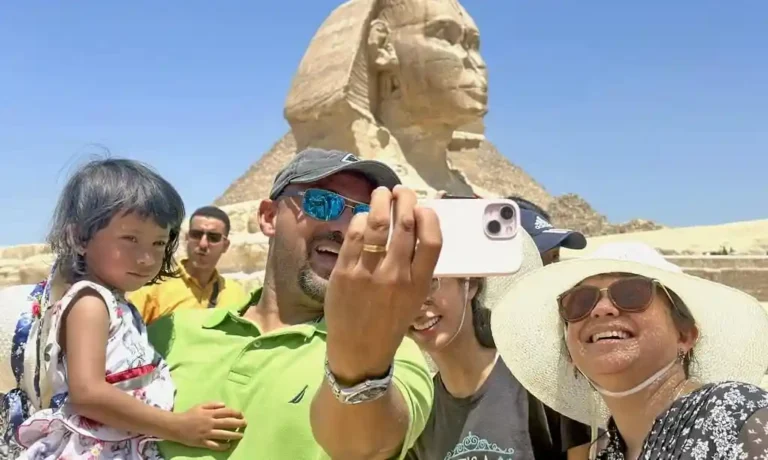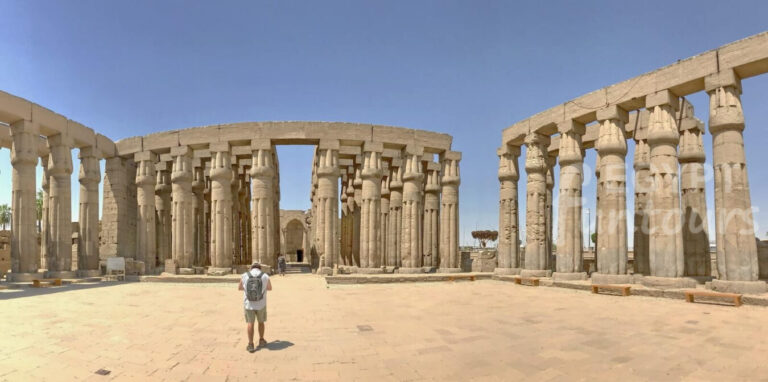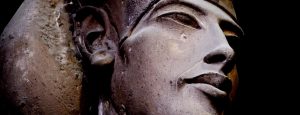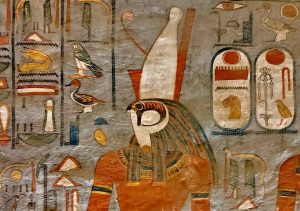Narmer Palette
King Menes hailed Upper Egypt’s triumph over Lower Egypt with his renowned Narmer Palette. We unearthed it from Hierakonpolis (El Kom El Ahmar), approximately 22 kilometers east of Cairo. The palette was moved from the Egyptian Museum in Cairo to the Grand Egyptian Museum. You can begin your journey to Egypt by visiting the Grand Egyptian Museum to see the palette.
Depictions in King Narmer’s Palette
The Narmer Palette features scenes sculpted in relief on both faces. These carvings symbolize the king’s victory over his enemies and their fortifications. The artist portrays the king as a bull, an animal considered one of the country’s most fearsome, along with the lion. This reflects the king’s might and dominance.
Symbolism and Representation:
- Egyptian Representation System: In this palette, we can appreciate the Egyptian system of representation, with the face and legs in profile and the torso in front. This technique provides a clear and coherent depiction of the figures.
- Propaganda Message: The palette serves as a real propaganda message, using different registers and scales to emphasize the importance of the characters.
- Unifier and Guardian: The king is portrayed as the unifier of Egypt, the defender, and guardian of the two lands against their aggressors. It is a recognition of Narmer or Menes as the first pharaoh of the first dynasty.
The Narmer Palette features two sides: the recto and the verso. King Narmer’s name, “Ne3Rmer,” sits inside a small square on both faces. Furthermore, the Cow Hathor protects this royal signature. As the deity of love and motherhood, her face flanks the name on either side.
Detailed Depictions:
Verso Side: On the “Verso” side of the palette, Narmer depicts Menes wearing the red wicker war crown of Upper Egypt, indicating that he has taken control of the entire country. The palette’s largest engravings depict two men intertwining serpentine necks of mysterious animals known as serpopards. At the bottom of the palette, the monarch, shown as a bull with horns, smashes through city walls and stomps on his foes. A priest, dressed in leopard leather, also follows four divine standards.
Recto Side: On the opposite side of the palette, “The Recto” depicts Narmer with his army preparing to strike down an enemy captured by the hair, and beneath his top feet are two men either dead or attempting to escape his wrath. Behind the king, a bald servant is holding his sandals, and in front of him is the sky god Horus watching and blessing King Narmer’s victory by bringing many enemy prisoners.
- At the very top of the palette are cows and bulls that are linked with the goddess Hathor of celebration and joy, depicted as a cow or a lady with cow’s ears. The bull is a sign of the king’s power and vitality.
Historical Context:
The Narmer Palette is not just an artistic masterpiece but a powerful historical document, showcasing the king’s role as the sole holder of power. It underscores the Pharaoh’s responsibility to maintain harmony and prosperity in the two lands, a true testament to the unification of Egypt under Narmer. The palette’s artistic coherence and beauty further highlight its importance in Egyptian history.
The Significance of the Narmer Palette to the Egyptian Museum
The Narmer Palette stands as one of the most pivotal artifacts in the Egyptian Museum, anchoring the very foundation of ancient Egyptian civilization. Discovered by British archaeologists in the late 19th century, this double-sided stone tablet is far more than just a relic; it is a historical monument that marks the dawn of Pharaonic rule.
A Symbol of Unification
Dating back to approximately 3100 BC, the Narmer Palette vividly captures the image of Pharaoh Narmer. On one side, he is shown wearing the crown of Upper Egypt, while on the other, he dons the crown of Lower Egypt. This dual depiction is not merely artistic; it symbolizes the unification of Upper and Lower Egypt under Narmer’s leadership. This unification is a cornerstone event, signaling the commencement of a centralized Egyptian state that would flourish for millennia.
Historical and Cultural Keystone
For Egyptologists, the Narmer Palette is indispensable. It represents the first known moment when Egypt was united under a single ruler, marking the birth of Egyptian civilization as we know it. This artifact isn’t just a historical record; it’s a cultural keystone that offers invaluable insights into Egypt’s formative years. The reign of Narmer initiated numerous dynasties and epochs, reflected in nearly every exhibit housed in the Egyptian Museum.
An Exhibition of Authority
While it may be housed in a simple display, the significance of the Narmer Palette transcends its physical presentation. Its carvings and inscriptions provide a rare glimpse into the early expressions of royal authority and divine kingship. Through its intricate designs, historians and visitors alike can trace the origins of many of the Pharaonic symbols and traditions that persisted for centuries.
In essence, the Narmer Palette is not just an artifact; it is a testament to the beginning of an unparalleled civilization. It holds the essence of Egypt’s rich history and plays a crucial role in illustrating the story of its enduring legacy.


























